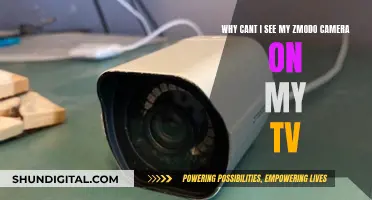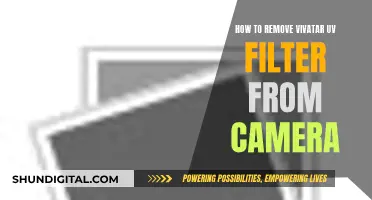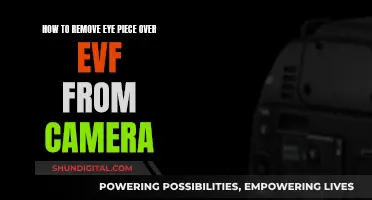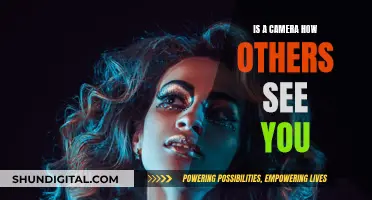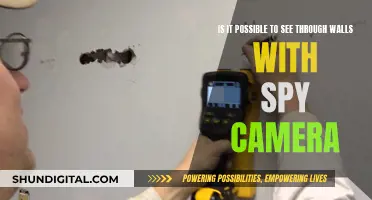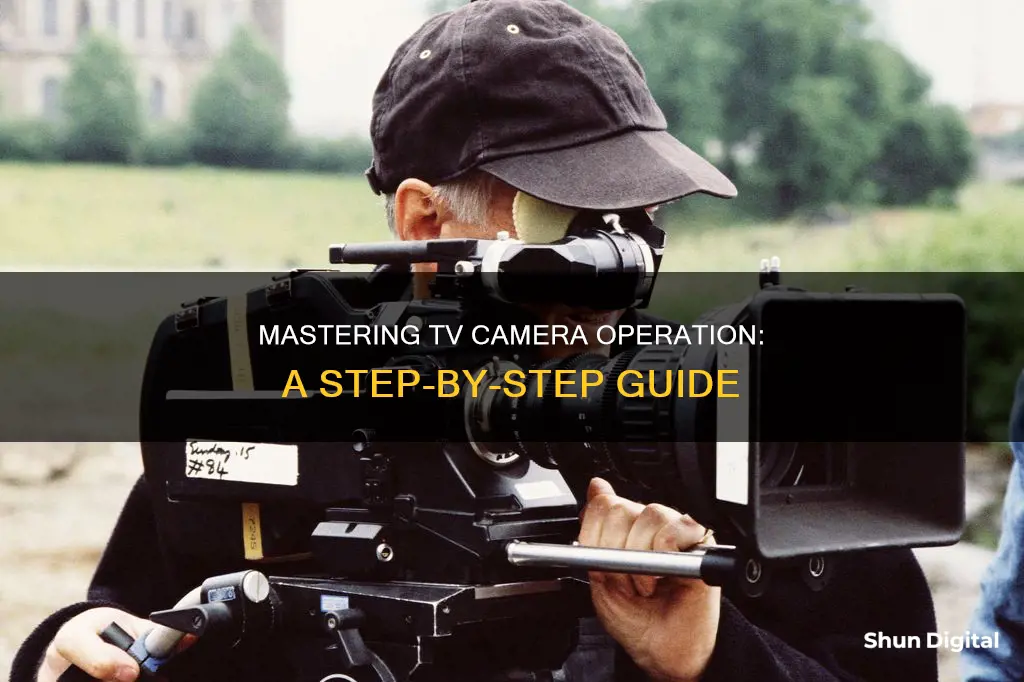
Operating a TV camera is a sought-after skill in the world of television. While working at a local TV station, an employee was assigned the role of lead cameraman simply because he was one of the few people in the building who knew how to operate a TV camera. Knowing how to operate a TV camera can open doors to unique opportunities, such as creating short features for TV channels or even becoming the lead cameraman for a show. Learning how to use a TV camera can be the first step towards a career in television, and it can also be a valuable skill for those interested in video production, filming, and editing.
What You'll Learn

Camera angles and framing
Basic Shots
- Establishing shot: Usually an exterior shot of a building where the action takes place, or a wide shot of a location. This type of shot is good for showing off locations, crowd scenes, or distancing the camera from the subject.
- Long shot: The subject's entire body is visible, but they do not fill the shot. This type of shot is good for keeping the subject in plain view amidst grander surroundings.
- Medium shot: Framing the subject from the waist up or the torso. This type of shot emphasises the subject while keeping their surroundings visible.
- Close-up: Framing the subject's face or upper body. Close-ups are good for intimate shots that show off facial expressions.
- Extreme close-up: The subject's face or attributes (eyes, hands, mouth, etc.) fill the entire frame. This type of shot is used when a specific detail needs to be shown.
- Two-shot: Featuring two characters in the frame. Can be done as a long shot, medium shot, or close-up.
More Complex Shots
- Over-the-shoulder: The camera is placed over one character's shoulder to focus on the other character, who is speaking. This type of shot is common in conversation scenes.
- Point of View (POV): The camera is used as the character's eyes, showing the audience exactly what the character is seeing.
- High angle shot: The camera is positioned above eye level, looking down on the subject. This angle can create a feeling of inferiority or looking down on the subject.
- Low angle shot: The camera is positioned below eye level, looking up at the subject. This angle can emphasise power dynamics between characters, making the subject appear more powerful or superior.
Does Your TV Spy on You?
You may want to see also

Interview techniques
Preparation
Before the interview, ensure you have all the necessary equipment and that it is set up correctly. This includes the camera, tripod, lighting, and microphones. Test the audio and video equipment to avoid issues during the interview. It is also important to choose an appropriate environment for the interview, considering factors such as lighting, background noise, and power outlets. If the interview is taking place in the interviewee's home or workplace, you may need to move furniture or adjust the lighting to get the best shot.
Camera Setup
If you are using a single camera, position it so that both the interviewer and interviewee can be seen clearly, without taking in too much of their bodies. Use a neutral background that allows the participants to stand out, and add lighting to help separate them from the background. Keep the camera at eye level so that all subjects can maintain eye contact with the interviewer and the camera without looking up or down.
Audio
To ensure the best audio quality, use a shotgun microphone or a lapel microphone. If you are using a single camera, the camera operator can monitor the audio levels, so the interviewer does not have to wear headphones, which can be distracting.
Framing and Composition
Avoid harsh lighting conditions by using a soft light in front of the participants. This will help to remove any excess lighting and create a more flattering look. When composing the shot, consider the background and try to use a bland backdrop to produce better results. Avoid any shadows being formed by subjects or equipment, as this can look amateurish.
Give your interviewee some discussion points before the interview to help them feel more comfortable and relaxed. However, avoid giving them the exact line of questioning, as this can make the interview feel rehearsed and less spontaneous. During the interview, speak clearly and avoid using acronyms or jargon. Keep your sentence structure uncomplicated and provide context for your answers. If you are asking questions off-camera, remember to nod rather than saying "hmmm" or "yep," as this can make the footage difficult to edit.
Editing
Shoot more footage than you need to have plenty of options during the editing process. This is especially important if you are planning to use B-roll footage to cut away from the subject's face at certain points. Ask the interviewee to mix the question into their answer to create a smoother feel in the final edit. For example, instead of simply answering "Black Sabbath" to the question "What is your favorite band?," they should phrase their answer as "My favorite band is Black Sabbath."
Blackvue: Accessing Your Camera Footage
You may want to see also

Getting the best shots
- Understand the different types of camera shots: Familiarize yourself with the various types of camera shots, such as the establishing shot, master shot, tracking shot, wide shot, two shot, over-the-shoulder shot, medium shot, close-up, and extreme close-up. Each type of shot serves a specific purpose and can help convey the desired emotion or idea.
- Choose the right equipment: Select a camera that fits your needs and budget. Consider factors such as resolution, the number and type of sensors, stabilization features, and whether you need waterproof or rugged designs for outdoor use.
- Find the right location: Choose a location that complements the story you want to tell and enhances the visual impact of your shot. Consider the lighting conditions and the surrounding environment to create the desired atmosphere.
- Experiment with different angles: Play around with different camera angles to find the most effective way to frame your subject. Try eye-level shots, low-angle shots, high-angle shots, and dutch angles to see how they impact the viewer's perception of the scene.
- Use movement effectively: Incorporate camera movement techniques such as panning, tilting, dolly movements, and tracking shots to follow the action or create a sense of dynamism. Be mindful of when to use static shots to emphasise the appearance and movement of your subject.
- Pay attention to framing: Ensure that your subject is framed effectively within the shot. Consider the rule of thirds or other composition techniques to create visually appealing and balanced images.
- Focus on lighting and exposure: Lighting and exposure play a crucial role in achieving great shots. Adjust your camera settings to accommodate different lighting conditions and avoid overexposure or underexposure. Position yourself to avoid lens flare or glare in your final image.
- Understand depth of field: Depth of field refers to the area in your image that appears sharp and in focus. Play around with shallow depth of field (where the subject is in focus while the background is blurred) and deep depth of field (where everything in the frame is in focus) to create different visual effects.
- Use zoom effectively: Zooming in on your subject can create a sense of intimacy and draw the viewer's attention to specific details. On the other hand, zooming out can give a sense of space and show the relationship between the subject and their surroundings.
- Consider the context: Always be mindful of the context of your shot. Think about the story you want to tell and how each shot contributes to the overall narrative. Use camera movements and angles to emphasise certain relationships or ideas.
Activating Your LG Smart TV's Camera: A Step-by-Step Guide
You may want to see also

Live vs recorded footage
Operating a TV camera is a skilled job and one that has evolved over the decades. While the technology has changed, the fundamentals of filming remain the same.
There are several differences between live and recorded footage, and each has its own advantages and disadvantages.
Live video is a great way to engage with your audience. It is a more immediate and personal way to connect with viewers, allowing them to feel part of the action and creating a sense of community. Live videos are also easier to produce as they do not require the same level of set-up or editing as recorded videos. They are a good way to practice speaking on the fly and can help you become more comfortable in front of the camera. Facebook, for example, favours live videos over pre-recorded ones as it can see the engagement and interaction in real-time.
However, pre-recorded videos are often more polished and are better for presenting ideas or specific information that needs to be conveyed clearly and concisely. They allow you to script and edit your content to ensure it is clear and concise. Pre-recorded videos are also better for reaching a wider audience as they can be shared and viewed at any time, whereas live videos are often shorter and more suited to a specific audience.
The choice between live and recorded footage depends on the purpose of the video, the platform being used, and the level of engagement desired. Both have their place and can be used together as part of a broader strategy.
When operating a TV camera, it is important to understand the strengths and weaknesses of each type of footage and to leverage them accordingly.
Cameras: Always Watching, Your Privacy at Stake?
You may want to see also

Camera movement
Pan
Moving the camera horizontally from left to right, or vice versa, while keeping its base fixed on a specific point is known as panning. This technique allows you to capture a panoramic view and is useful for revealing a larger scene, such as a crowd, or something off-screen. Panning can also help establish the location or follow a moving character.
Tilt
Tilting involves shifting the camera's view up or down without changing its horizontal direction. This movement gives you control over the camera angle and helps fit more into a single continuous shot. Tilts can be used to reveal objects or people who were previously off-screen, adding an element of surprise to the scene.
Zoom
Zooming is a widely used camera movement that enables you to quickly focus on a specific area in the frame without physically moving the camera. It can be used to move closer to the subject (zoom in) or farther away (zoom out). However, excessive zooming can degrade image quality, so it should be used sparingly.
Pedestal/Boom
The pedestal movement involves moving the entire camera up or down on a pedestal or tripod, as opposed to just tilting the camera angle. This movement is useful for shooting tall subjects or capturing a subject from eye level while framing a building or other tall objects.
Dolly
The dolly movement is when the camera moves toward or away from the subject, often by placing it on a track or motorized vehicle. "Dolly in" moves the camera closer, while "dolly out" moves it backward. This technique is effective for building tension or adding significance to a scene, especially when a character is lost in thought or has a sudden realisation.
Truck
Similar to the dolly movement, trucking involves moving the camera laterally to the left or right while maintaining a fixed point, often on a stabilised track. This movement is useful for action sequences when you want to keep the camera focused on a moving subject.
Tracking
A tracking shot is when the camera moves alongside the subject, often following the horizontal axis as the subject moves. It is commonly used in walking and talking scenes to keep the camera on the subjects. Tracking shots are also ideal for showcasing a stretch of road or scenery.
These are just a few basic camera movement techniques used in television and film production. Each movement serves a specific purpose and helps shape the narrative, enhance storytelling, and direct the audience's attention.
A Guide to Operating Spy Watch Cameras
You may want to see also
Frequently asked questions
If you own a DSLR camera, you can start by signing up for a course that teaches you the basics of operating a TV camera, conducting interviews, and getting the best shots.
Learning how to operate a TV camera can open up opportunities in the television industry, such as working as a cameraman or cameraman for live events.
Yes, there are online tutorials and courses available that can teach you the basics of TV camera operation and video production.
Some key techniques include learning how to frame and compose your shots, adjust the focus and exposure settings, and use proper lighting to get the best image quality.



